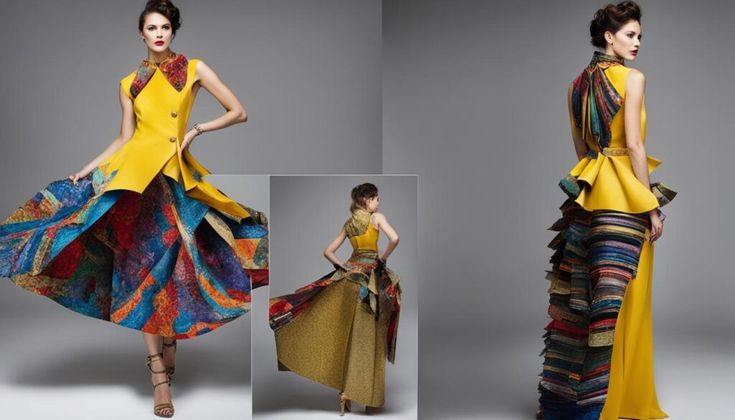The high-fashion landscape, once a pristine temple of virgin cashmere and untouched calfskin, is undergoing a radical and necessary transformation. The clarion call of sustainability, amplified by a new generation of conscious consumers, has shattered old norms. In its place, a new paradigm has emerged, not from the hushed ateliers of Paris or Milan, but from the creative crucibles of innovation: Upcycled Luxury. This is not a fleeting trend relegated to a seasonal collection; it is the undeniable, dominant future of high fashion. It represents a profound shift from linear consumption to a circular, creative, and deeply ethical model that is redefining what true luxury means in the 21st century.
Beyond a Trend: The Core of Upcycled Luxury
To call upcycling a mere “trend” is to misunderstand its profound significance. Unlike simple recycling, which often breaks down materials to their base form (sometimes diminishing their quality), upcycling is an act of creative alchemy. It involves taking pre-existing, often discarded materials or garments and transforming them into a product of higher value, quality, and aesthetic appeal.
In the realm of luxury, this isn’t about cutting up old t-shirts. This is about meticulously deconstructing a vintage Chanel tweed jacket, a damaged Hermès scarf, or flawed rolls of Loro Piana wool that never made it to a production line. Designers then reimagine these materials, infusing them with new life, narrative, and purpose. The result is a one-of-a-kind piece that carries the history of its original form while boldly asserting a contemporary identity. This process champions uniqueness, craftsmanship, and a tangible connection to fashion’s past, making mass-produced items feel utterly obsolete.
The Powerful Drivers Fueling the Upcycled Revolution
The meteoric rise of upcycled luxury is not accidental. It is a direct response to a powerful confluence of cultural, economic, and environmental forces.
A. The Conscious Consumer Awakening
The modern luxury shopper, particularly Millennials and Gen Z, is radically different from their predecessors. They are hyper-informed, digitally native, and ethically driven. Their purchasing decisions are extensions of their values. They demand transparency, ethical production, and environmental responsibility. Wearing an upcycled piece from a renowned house is a powerful statement—it signals style, wealth, and a commitment to the planet. It is luxury with a conscience.
B. The Inescapable Environmental Imperative
The traditional fashion industry is one of the world’s worst polluters. The statistics are staggering: it accounts for nearly 10% of global carbon emissions, is a primary consumer of water, and contributes massively to landfill waste. The “take-make-dispose” model is fundamentally broken. Upcycling directly attacks this problem at its core by drastically reducing waste, conserving raw materials, and slashing the carbon footprint associated with producing new textiles from scratch.
C. The Thrill of Radical Exclusivity
In an era of influencer hauls and instant gratification, true exclusivity has become the ultimate luxury. While a brand may produce thousands of a certain “it-bag,” an upcycled piece is, by its very nature, singular. It can never be perfectly replicated. This offers a level of personalized exclusivity that even the most prestigious brands struggle to provide with their main lines. Owning an upcycled garment means owning a piece of wearable art with a unique story, making it the antithesis of fast fashion.
D. Economic Savvy and Value Retention
High-end upcycling offers compelling economic logic. For brands, sourcing vintage deadstock or flawed materials can be more cost-effective than producing new textiles, though the labor-intensive process balances this. For consumers, investing in a unique upcycled piece from a luxury label often means investing in an asset. These items hold and often appreciate in value due to their rarity and the growing demand for sustainable collectibles.
Spotlight on the Vanguard: Designers Leading the Charge
A wave of visionary designers and brands, from established houses to rebellious newcomers, are placing upcycling at the very heart of their ethos.
A. Marine Serre: The Prophet of Radical Renewal
Perhaps the most iconic figure in this movement, French designer Marine Serre has built her entire brand on the concept of “future wear.” Her collections famously feature up to 50% reclaimed materials. She transforms antique silk scarves into stunning dresses, old blankets into tailored coats, and lycra leggings into her signature moon-print bodysuits. Her work is not just about sustainability; it’s a sharp, stylistic vision of what fashion must become.
B. Marine Serre: The Prophet of Radical Renewal
The Italian luxury giant made a seismic impact with its Fall 2020 “Upcycled” collection. In a bold move, Creative Director Demna Gvasalia declared that the collection would not be season-specific but permanently available, produced on-demand to avoid waste. The line features pieces crafted from vintage deadstock materials, including repurposed army blankets, hotel curtains, and archived scarves. This project reframed upcycling not as a niche concept but as a core, viable business model for a global powerhouse.
C. Stella McCartney: A Lifelong Commitment
A pioneer of sustainable luxury long before it was fashionable, Stella McCartney has consistently incorporated upcycled and recycled materials into her collections. From garments made from reclaimed nylon and polyester to accessories created from leftover materials, her work proves that ethical fashion can be commercially successful, incredibly desirable, and effortlessly chic.
D. E.L.V. DENIM: Mastering the Art of Transformation
This London-based brand specializes in hyper-exclusive upcycled denim. Founder Anna Foster takes two vintage pairs of Levi’s typically one black, one blue and deconstructs them to create a single, perfectly balanced pair of jeans. The result is a zero-waste product that is both a homage to denim history and a modern fashion statement, coveted by celebrities and fashion editors alike.
The Tangible Challenges on the Path to Dominance
Despite its promise, the path for upcycled luxury is not without significant obstacles.
A. The Scalability Conundrum
The very essence of upcycling its hands-on, artisanal, and unique nature makes it difficult to scale. How does a major brand produce thousands of unique units efficiently? The solution lies in a hybrid model: integrating limited upcycled capsules within a larger collection while overhauling mainline production to incorporate more recycled (rather than upcycled) materials.
B. Sourcing and Consistency Complexities
Sourcing high-quality vintage materials in consistent quantities is a constant challenge. A designer may find a bolt of incredible deadstock fabric but may never be able to find it again. This requires immense flexibility and creativity in the design process, moving away from rigid seasonal plans to a more adaptive approach.
C. Consumer Perception and “Used” Stigma
While rapidly changing, some lingering perception remains that “upcycled” is a fancy word for “second-hand” or “used.” Education is crucial. Brands must effectively communicate the value, artistry, and exclusivity of these pieces, positioning them not as cast-offs but as elevated, conscious collectibles.
D. The Premium Pricing Justification
The intensive labor involved in sourcing, deconstructing, cleaning, and remaking garments commands a high price. Consumers need to understand that they are paying for unparalleled craftsmanship, exclusivity, and a sustainable ethos, not just the raw materials.
The Future is Circular: What’s Next for Upcycled Luxury?
The trajectory is clear. Upcycled luxury will continue to evolve from a niche offering to a central pillar of the entire industry.
A. Technological Integration: Advancements in technology will play a huge role. AI and data analytics can optimize the sourcing of deadstock materials. Digital product passports using blockchain technology will become standard, allowing consumers to scan a garment and learn the entire history of its materials—a powerful tool for transparency and storytelling.
B. Collaborative Ecosystems: We will see more collaborations between luxury brands and specialized upcycling studios or vintage archives. These partnerships will allow major houses to tap into expertise and material sources outside their own supply chains.
C. Legislative Tailwinds: As governments worldwide begin to impose stricter regulations on fashion waste and enforce extended producer responsibility (EPR) laws, upcycling will transition from a voluntary ethical choice to a strategic business imperative.
D. Mainstream Assimilation: The influence will trickle down. High-street brands are already launching their own upcycled lines, further normalizing the concept and making sustainable choices accessible to a wider audience. This, in turn, pushes luxury to innovate even further.
Conclusion: The Unstoppable Ascendancy
Upcycled luxury is far more than a aesthetic movement; it is a cultural and commercial revolution. It successfully reconciles the apparent dichotomy between desire and responsibility, between exclusivity and ethics. It offers a compelling answer to the existential questions facing the fashion industry about its waste, its impact, and its relevance in a changing world.
The future of high fashion will not be found in a pristine new bolt of fabric. It will be discovered in the archives, in the deadstock warehouses, and in the creative genius of designers who see not waste, but potential. It is a future that honors the past while forging a more thoughtful, beautiful, and responsible path forward. The age of upcycled luxury is not coming; it is already here, and it is dominating the conversation one exquisite, reinvented piece at a time.














